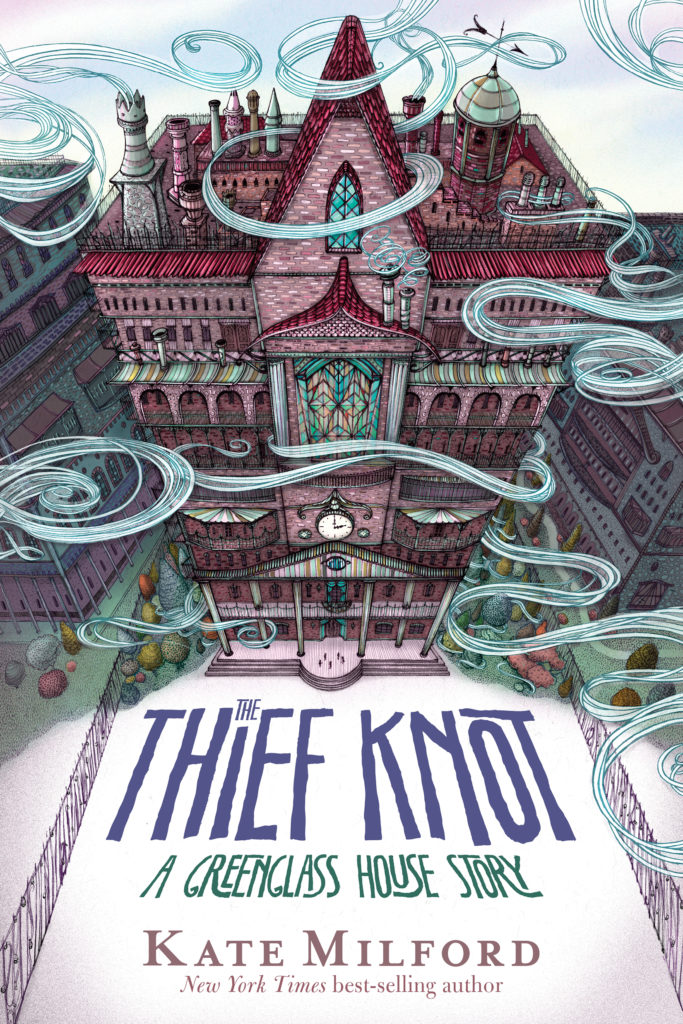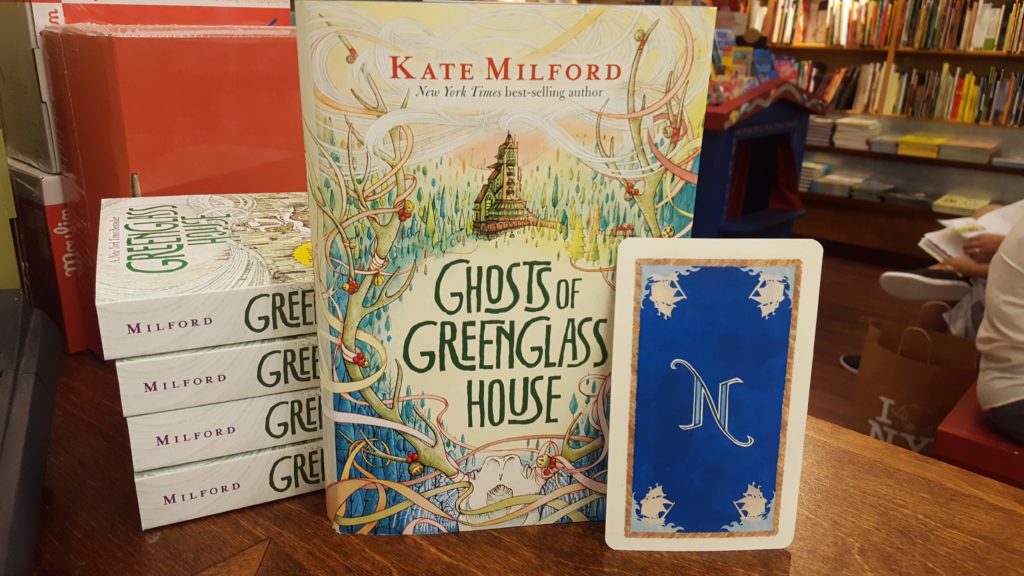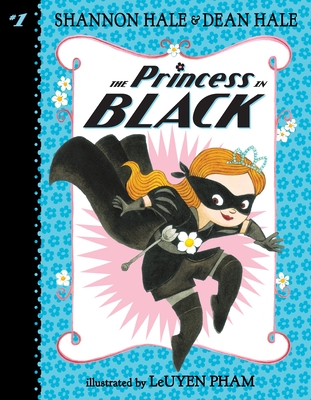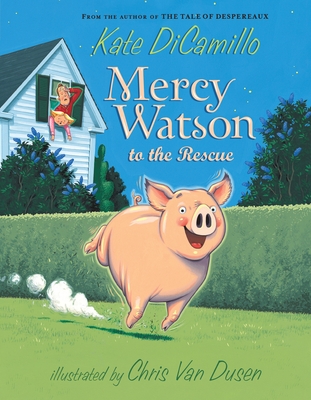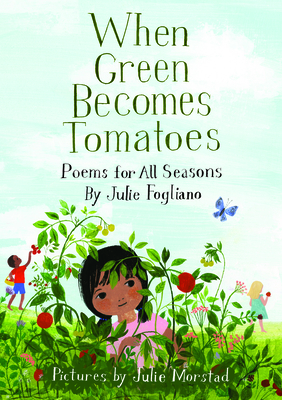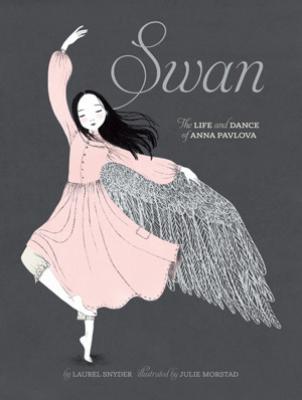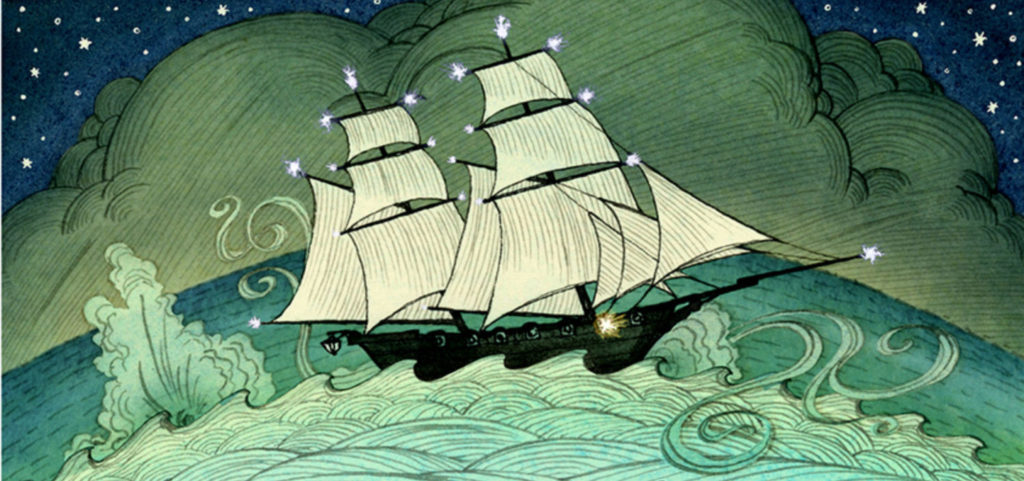
Posts by Kate:
- Proof of purchase of Ghosts of Greenglass House in hardcover from any retailer;
- Proof of purchase/preorder of Ghosts of Greenglass House in paperback from a brick-and-mortar bookstore of your choosing.
Presenting THE THIEF KNOT!
February 13th, 2019YOU GUYS.
Is that a thing of beauty, or what? With cover and illustrations by the outstandingly amazing Jaime Zollars, The Thief Knot is coming your way November 5, 2019! That’s right, THIS NOVEMBER!
Here’s a very brief summary, because even telling you too much about this one is a spoiler for both Greenglass House books, but especially Ghosts of Greenglass House:
Ghosts, a kidnapping, a crew of young detectives, and family secrets mix in this new standalone mystery set in the world of the bestselling Greenglass House, from a National Book Award nominee and Edgar Award-winning author.
The way I describe The Thief Knot is that it’s like Greenglass House meets Ocean’s 11, and it’s set in one of the weirdest parts of Nagspeake, the Liberty of Gammerbund. If you’ve read The Left-Handed Fate, you’ve visited the Liberty with Lucy Bluecrowne. If you’ve read Ghosts of Greenglass House, you’ve met some of its denizens. That gorgeous piece of architecture you see up there on the cover is Marymead Intermediate House, where certain of our heroes…(drumroll)…attend middle school.
I hope you’ll join me on this new adventure. It’s been a joy to write, and I can’t wait to welcome you back to Nagspeake this fall.
Bluecrowne has a trailer!
November 5th, 2018It’s been a month since Bluecrowne entered the world in its beautiful new incarnation, and I’ve mostly spent that time traveling, so I haven’t had time to post this gorgeous new trailer (my first!). Enjoy, and share as you see fit. Fair winds and following seas, friends!
Countdown to Ghosts of Greenglass House in Paperback, plus a Gift!
July 21st, 2018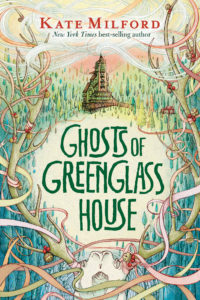 I can’t quite believe it, but Ghosts of Greenglass House has just launched in its beautiful new paperback incarnation on July 31! In celebration, I did something I’ve been meaning to do for a year.
I can’t quite believe it, but Ghosts of Greenglass House has just launched in its beautiful new paperback incarnation on July 31! In celebration, I did something I’ve been meaning to do for a year.
Some of you may already have read Ghosts of Greenglass House. If you have, thank you. I love it deeply, even more than I love its predecessor. (Yes, I love Greenglass House. But it was never my favorite among my own books. Ghosts…might be.) And if you’ve read Ghosts, you might remember that there’s a very special deck of cards mentioned in the text. (If you haven’t read it, here’s the thing: there’s a very special deck of cards mentioned in the text.)
I’d been meaning to make a bookmark in the style of a card from a deck like that one, but I never quite got past the initial sketches, possibly due to last year’s other release: my second child, Tess.
But.
Guys. I finished it! Here it is, the Knave of Dials, AKA the Gentleman Maxwell, one of the legendary smugglers of Nagspeake, from the Court of Runners card deck!
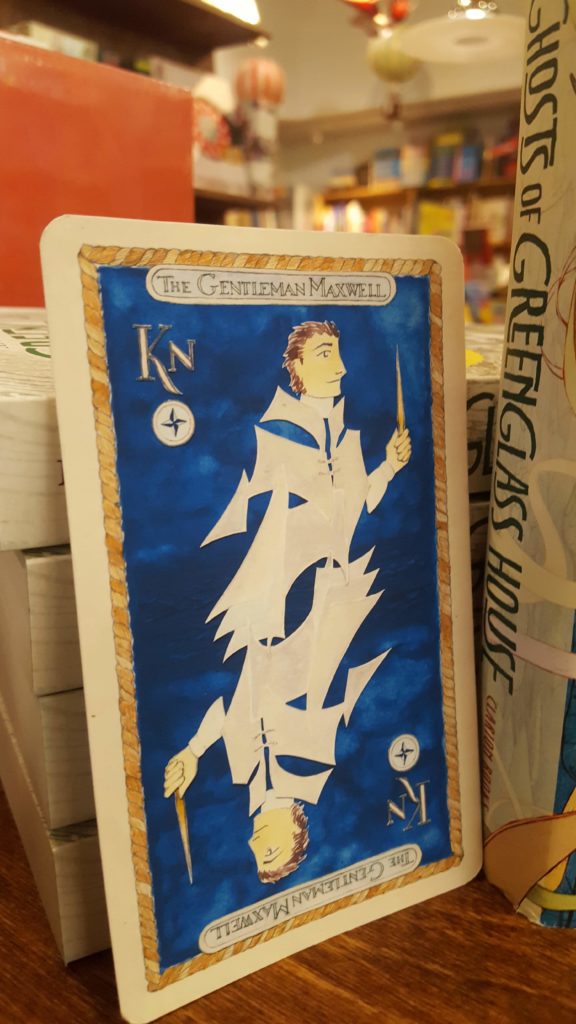 I made these from cut paper, ink, watercolor, and pencil. They’re roughly tarot-sized, and make perfect bookmarks, and I would love to send one to you!
I made these from cut paper, ink, watercolor, and pencil. They’re roughly tarot-sized, and make perfect bookmarks, and I would love to send one to you!
Reply to this post with proof of one of the following and I’ll mail a Knave to you (your reply will be kept private):
Any purchase from July 2018 onward will qualify, while my supplies last. Want your copy signed or personalized? Order yours from McNally Jackson Books and it can be done.
Happy reading! I hope you love Ghosts as much as I do. And stay tuned! Preorder goodies for Bluecrowne (October 2018) available now too! Click here for more on that…
#kidlitwomen: A Letter to My Son About a Line on His Nightly Job Chart
March 31st, 2018
Well, it’s almost midnight on the last day of #kidlitwomen’s month of posts, and if you’ve been following this event, then throughout March you’ve been reading the words a host of women who are much wiser than I, tackling issues without easy answers and discussing solutions.
I started literally ten separate posts, but none of them worked, possibly because most of the things I most wanted to talk about had already been covered by the aforementioned much wiser people than I.
But today I worked my usual Saturday shift at my bookstore, and I had a couple of interactions where I had to work around that noxious boy book/girl book thing. (Shannon Hale’s post on this subject from March 1st is absolutely fantastic.) This happens almost every weekend. I do my best to counteract it customer by customer. Then I come home and do what I can to make sure I’m raising a boy who values stories about girls just as much as stories about boys. Here was my home turf action item for today.
Dear Griffin,
I know you have not been totally excited about the new jobs chart we made for you. You’ll just have to take my word for it that there’s a good reason you have to clear your place and feed the dogs. As a sort of compromise, I’m letting you have an extra gummy bear with your vitamins before bed.
Also, we added an extra job to your list. You have to read a book every night before bed to your baby sister.
The choice of book is entirely up to you. I’d prefer you chose something narrative and not the Lionel train catalog, but if you make up a story about the trains and don’t just use it as an opportunity to tell Tess which ones you want for your birthday, I’ll let it slide.
However, you have some favorite books that I think would be really great to share with her. Here are some thoughts to help you pick what to read to her tonight.
THE FRIEND SHIP. Because you are Tess’s first and best friend. And because as the two of you sail out into the world, following whatever squirrelly maps you find, you’ll be okay as long as you have each other.
MISS RUMPHIUS. You’ve been able to recite most of this book since you were three, and last summer you went around pointing out all the flowers in Brooklyn that you thought looked like lupines. I can’t wait to see how you will choose to make the world more beautiful.
BABY LOVES QUARKS. Because if Tess is anything like you, she’s going to be super excited about learning about how the world works. She’s going to have lots of questions, and she might ask you before she asks your dad and me. Don’t forget it’s okay to tell her you don’t know. Then the two of you can work together to find out the answer.
ADA TWIST, SCIENTIST. Because you’ll have to teach her how to Science before the two of you skip off into the sunset to find those answers.
THE PRINCESS IN BLACK. Because superheroes are awesome and beasts need help behaving. Somedays you’re the princess, some days you’re the monster. Just please explain to her that really toenail clippings are not for eating, because you know how she tries to eat everything.
MERCY WATSON. Get her started on these now, so we can read her WHERE ARE YOU GOING, BABY LINCOLN as soon as humanly possible. You and I have sat up late plenty of nights reading about how Baby struck out on her own to go on a necessary journey. Tess, like you, will need to know how to recognize when it’s time to go on one for herself.
EXTRA YARN.
Annabelle finds something that turns out to be miraculous when she shares it with her family and her community. I’ll even give you a ball of yarn, so you can show Tess how to “knit.” Just remember cleaning up is also on your job chart.
THE MOST MAGNIFICENT THING. Because you know how you love to build? Tess is going to need to learn what you’re already figuring out–that not everything turns out perfectly the first time.
WHEN GREEN BECOMES TOMATOES. Sometimes a handful of small, sweet, shiny gems are the exactly-right bedtime treats.
SWAN. Because both of you love to dance, and because only very special and beautiful books really work best when you dance while you read them.
I hope this is the one job on your chart that you look forward to every night, and I hope you read Tess every single book you love. Help her find the stories she loves, when she’s old enough to tell you what they are. I hope you’ll keep reading together, about girls and boys and frogs and toads and planets and trains and Pooh and Piglet, and I hope you talk with her about the stories you read, just like we talk to you. I hope that when she tells you stories, you help her understand that her tales, just like the ones you read together, are important and valuable, and not just to her. To you. To the world.
(Note that I’m not putting all of that on your job chart; you can read her one book and be done. Sometimes she’s super wiggly. She might not sit for a serious discussion.)
Also remember she’s going to try and chew whatever you pick, so be prepared.
Love,
Mommy
NYT Nonsense: A Brief Update
December 28th, 2017It’s midnight and I’m on vacation, so keeping this brief in hopes that I’ll be able to report back more positively later in the week.
A couple weeks ago I gave an interview to a reporter at the New York Times on the subject of sensitivity readers (for my general opinions, see my previous blog post, which I wrote up right after an NPR interview on the same subject earlier this year). When the article was finally released, I was shocked at how my words had been used. I went on a Twitter rant you can read here.
I’ve emailed the author of the piece expressing my issues with the quote and asking that she rectify the situation. She replied by explaining her intentions and inviting me to write a letter to the editor. I wrote back explaining in more depth why her choice of quotes misrepresented my position and was damaging to the discussion, and requesting either a correction or a removal of myself from the piece.
I try very hard to assume good intentions, and I have every hope that the author of the article will do what is right. Hopefully the discussions happening now will finally, FINALLY inspire someone to write a better take on sensitivity/authenticity readers in kidlit: one that centers someone other than the authors. Like, you know, the young readers or something. Maybe.
I’ll report back if there’s an update of any kind, but for now I’m going to bed. Goodnight, all.
On Sensitivity Readers; a Very Long Post
February 27th, 2017Warning: this is a long post.
There have been a number of articles on sensitivity readers in the last few weeks. Slate ran this one; Huffington Post this one over here; here’s the Washington Post. There are others. Google a few more if you want. Then go to Writing at the Margins, where you’ll find a description of what sensitivity readers do, just in case you weren’t already aware.
I’m a person who believes in sensitivity readers, in the first place because I’m a person who generally believes in having expert readers look over my manuscripts before my I call my books finished, but also because I write for kids. I think when you write for kids, the stakes are, in general, higher than they are if you write for adults, and I believe, basically, in taking the feelings and well-being of my readers into consideration. I don’t think I began my career in middle grade literature feeling quite so strongly about this, by the way–more on that below. But suffice to say, while writing Ghosts of Greenglass House, I made sure to find readers who could look at several aspects of the story that were outside my direct knowledge and experience.
This, by the way, if you read the comments on any of the articles I linked to above, apparently means I caved to excessive political correctness and allowed a bunch of overly-sensitive censors to water down a story that might otherwise have been original. I invite you to please imagine me either laughing my ass off as I type this or reading it with a heavy dose of sarcasm. Because I feel that, as with every other expert reader whose assistance I’ve requested in the course of writing a book, the input of these readers was invaluable. Simply put, their feedback made Ghosts of Greenglass House better. More on that below, too.
A couple weeks ago, I was honored to join Jennifer Baker and Jordan Brown on a panel moderated by Justina Ireland and presented by the Children’s Book Council. The panel was called “A Second Opinion: Utilizing Sensitivity Readers.” The panel was geared towards children’s and young adult publishing professionals who were interested in some best practices for working with sensitivity readers. Jennifer is an editor, author, and sensitivity reader; Jordan is an executive editor at HarperCollins; Justina is an author and maintains the Writing in the Margins website, including a database of sensitivity readers. I was there as an author who’d utilized sensitivity readers. Publisher’s Weekly did a nice write-up of the event; you can read it here.
After that panel, I was contacted by a correspondent at NPR who was looking for an author who’d used sensitivity readers to answer some questions for a piece that I believe will air tomorrow (Tuesday). [Tuesday edit: Here’s the link to that interview, which also features my dear friend and colleague, author Dhonielle Clayton, as well as author Hillary Jordan.] Because I’m always afraid I’ll sound incoherent or rambly when I’m speaking off the cuff, I made some notes, and because I don’t know what parts of our discussion the NPR piece will ultimately use and because I didn’t wind up saying everything I’d written down, I decided to write my notes up as this post. The headings below are questions I anticipated being asked, followed by what I wrote up to help me organize my thoughts when I answered.
Isn’t this all a bit too much, the idea of hiring people just to avoid being insensitive? And paying them, too?
I do not. I love that sensitivity readers exist, and I am in awe of their generosity. These are people who are willing to share their knowledge and personal, lived experiences with complete strangers in the interests of bringing better stories into the world. And not all of these experiences are pleasant to relive and rehash, which, in addition to compensating basic time and effort, is one reason why paying sensitivity readers is important.
They do this so readers–and since I’m coming to this from the world of young people’s literature, I mean specifically kids–have a chance to see themselves and others like them reflected in books that feel authentic, that value their own feelings and experiences, and that tell those readers that they’re important and worth seeing in literature. I love the generosity of sensitivity readers because not only are they willing to give their time and emotional energy, they’re willing to do this in order to make literature a better place for another generation of readers. They’re willing to deal with the middlemen–authors like me, and all of our errors, assumptions, and ego–in order to make a positive change for strangers they’ll never meet.
And as for being paid–we’re talking about hiring people to do work, and people who do work should get paid. Editors get paid, copyeditors get paid–reading and critiquing a complete manuscript is work, and deserves to be compensated. Full stop.
Why did you feel you needed sensitivity readers for your book?
In Greenglass House and its forthcoming sequel, the main character is a transracial adoptee. In the first book, in addition to solving a mystery, Milo was dealing a bit with questions about his unknown birth parents. In the second book, he’s dealing a bit with the complications of being Chinese in a white family and feeling a bit alienated from his ethnic heritage.
With past books–and in retrospect I wish I’d done this differently–I’ve relied on my own research. And I do have a significant amount of personal experience with the international adoption process–my husband and I have been in the process ourselves for a number of years, and after numerous trainings and homestudies and conferences with social workers, I know that transracial families frequently if not always have to contend with complications about race and heritage. But I have never experienced myself what my character and his family are going through and I wanted to try and be as true to that experience as possible. Because of that, during the revision process of Ghosts of Greenglass House, I arranged for three transracial adoptees from different backgrounds to read the book and give me feedback, as well as two non-adoptee Chinese-American readers and two additional readers looking at other concerns.
I want to write the best possible book I can, and the most accurate book I can. I’m a very good researcher, but even after three years’ worth of preliminary research, when I wrote a book set on a privateer during the War of 1812 I lined up two experts for feedback. In books where I’ve had characters speaking languages in which I’m not fluent, I’ve had experts check my translations. Asking someone to read for perspective when I’m writing outside my own personal experience feels not at all different to me from those things. It’s not that I can’t empathize or do the imaginative work myself; it’s about improving accuracy and adding depth and detail, except I would mind less if someone found an error in how I’ve described a schooner than I’d mind if someone found that I’d been inaccurate or insensitive in writing a transracial adoptee. My inaccuracy isn’t going to hurt the schooner.
Which brings me to the more important point. I write for kids. If I’m going to ask them to go with me on an adventure that might be challenging, might be sad or difficult or frightening, I need them to trust me. I need them to believe that I’m on their side. If I somehow signal to them that maybe I’m not–that maybe I don’t understand them or don’t understand their experiences or that I don’t know what I’m talking about, then at best I’ve lost them. At worst, I risk doing harm.
Yes, harm. You’re free to agree or disagree, but for myself I believe that the way that children see similar kids represented in books can make a difference about how they feel about themselves, and how they understand (correctly or not) the way they fit into the world. I’m perfectly willing to scare a kid (see my published works), but I’d rather err on the side of not making them feel crappy about themselves than they already might. Childhood and adolescence can be pretty brutal to start with. I prefer not to add to it.
So for me, working with sensitivity readers is less about trying not to offend anyone (there’s no way to guarantee against that, because no two people read the same book the same way) and more about a) at minimum actively trying not to do harm to the very vulnerable audience I write for and b) ideally trying to write the best book for them, the one that they can read and think, this book was written for me.
What did you get from the experience?
I was fortunate in that, for Ghosts of Greenglass House, the readers didn’t find any massive, big-picture issues that needed to be addressed. Most of the issues were small and subtle, things that probably never would have occurred to me on my own, based on my own experience.
For instance, this is a sequel, and in reintroducing my main character and his family, I referred to his parents as ‘his adoptive parents.’ This, of course, was accurate, but the readers all felt that, since we were in the POV of the adoptee protagonist, referring to his parents that way felt distancing. I had chosen that phrasing out of convenience, as a way to quickly remind readers of Milo’s family situation, but from the perspective of readers who were also adoptees, that choice undermined the otherwise tight-knit family I thought I’d written. And it was an easy fix. Most of the critical feedback I got was like that–subtle things, but meaningful, especially to young readers and their families who might in some way or other identify with the characters.
And then there were what I’d call missed opportunities–things that the sensitivity readers had personally experienced that they were generous enough to share with me so that I could share them with the characters, or places where they saw the opportunity for me to make a stronger storytelling choice, or one that would resonate more deeply with kids in family situations like my protagonist’s. One reader reminisced about how her family helped her connect with her heritage through food and suggested I might use that to help show Milo’s family encouraging his efforts to connect with his. Another reader suggested I change a character’s name. Her suggestion for a replacement was way better than what I had started with, and because it relied on language fluency I don’t have, I would never have made that choice without her input. Two readers mentioned feeling alienated by family tree projects in elementary school, and with their permission, I gave that experience to someone in the book to share with Milo–after everyone also said they wanted more from that particular character.
Those things added beautifully to the story and made it richer. That’s an important thing to mention: this process isn’t just about someone telling you what you did wrong. It’s about making the story better, and not just for your sake, but for your target readers.
But political correctness! Censorship! Blaaaahhhhh!
Okay, stop. An author can, in fact, write whatever the hell he or she wants. Actual fact. You can write outside your cultural experience or not. If you do, you can hire a sensitivity reader or not, and if you do, you can follow the advice that person gives or not. So for a writer, it really is up to you. Just remember that if you put what you write out into the world, the public has a right to comment on it. There are a lot of good arguments for sensitivity readers. We’ve discussed some of them. But no one’s going to make you do it.
Unless, potentially, you decide to work with a publisher. Because once you sell your book to a publisher, you enter into a partnership, and you aren’t the only one making decisions about that book anymore. That’s just the way it works. If you feel you need to be the only one making decisions about the story you’ve written, and if you don’t look at the story as belonging to anyone but you–and some writers do feel that way, which is their choice–then the traditional publishing model might not be ideal for you. And today there are myriad alternative publishing options and platforms available to writers who want complete control over their projects.
If you do sign with a publisher, and if you the author choose not to worry about a sensitivity reader and the publisher does and this results in a disagreement, then presumably you work together to solve it as you would any disagreement that crops up during the editing process. I mean…that’s kind of what the editing process is about.
And I do think publishers–or at least publishers of books for young readers–should at least think about sensitivity concerns. I think they should utilize sensitivity readers and consider very carefully the feedback those readers give. For one thing, public opinion can impact sales, and using sensitivity readers can help identify potential issues before the book gets to print, which is just better for everyone.
But more importantly than that, in a perfect world, publishers of books for kids should be concerned with more than the bottom line. They should be concerned with doing right by their readers, and doing their best to be sure that the books they publish don’t perpetuate stereotypes or include potentially damaging elements. And even though what constitutes “harmful” is not always a clear-cut matter–look at any book that’s caused any kind of controversy in this way and you’ll find conflicting opinions–I think it’s incumbent upon publishers to think critically and seek informed voices and opinions to aid in making their decisions when in one of those potentially gray areas. The point isn’t to never ever offend anyone ever–because again, impossible–but to do due diligence and make informed editorial decisions before the book goes to print.
And if you’re still reading after all that, hey, thanks.
Ghosts of Greenglass House Cover Reveal and Excerpt, Plus The Left-Handed Fate on the Locus Recommended Reading List!
February 4th, 2017
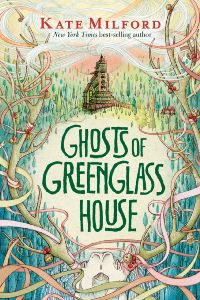 Oh, I am so late on this post, mostly because I’ve been in the thick of finishing a set of revisions for the book itself, but just in case you missed it, Entertainment Weekly was good enough to host a cover reveal for Milo and Meddy’s next adventure, Ghosts of Greenglass House. And here it is!
Oh, I am so late on this post, mostly because I’ve been in the thick of finishing a set of revisions for the book itself, but just in case you missed it, Entertainment Weekly was good enough to host a cover reveal for Milo and Meddy’s next adventure, Ghosts of Greenglass House. And here it is!
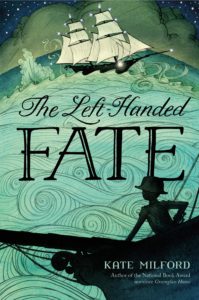 If you click on that EW link above and scroll past the awkwardly-large picture of my face, you’ll also find an excerpt to tide you over until October 3, when Ghosts of Greenglass House arrives at a bookstore near you. Enjoy! And in the meantime, if you need a little more Nagspeake in your life and you haven’t already picked up my beloved, current favorite-book-I’ve-ever-written, The Left-Handed Fate, what are you waiting for? It’s currently sitting pretty on the Locus Recommended Reading List, in some pretty amazing company.
If you click on that EW link above and scroll past the awkwardly-large picture of my face, you’ll also find an excerpt to tide you over until October 3, when Ghosts of Greenglass House arrives at a bookstore near you. Enjoy! And in the meantime, if you need a little more Nagspeake in your life and you haven’t already picked up my beloved, current favorite-book-I’ve-ever-written, The Left-Handed Fate, what are you waiting for? It’s currently sitting pretty on the Locus Recommended Reading List, in some pretty amazing company.
Happy reading!
A Post about Biggest Things
August 20th, 2016A couple months ago when I thought maybe, maybe if I tried really hard, I’d manage a couple blog posts a week leading up to launch time, I asked some friends what would make good topics, because I am notoriously bad at figuring out what kinds of things might be interesting to the reader who just happens to land here. Dylan Meconis said she’s always interested in what the biggest challenge of a given project is, which got me thinking and ultimately resulted in a very short list of “biggests” related to The Left-Handed Fate. Here it is.
Biggest challenge of the writing (thank you, Dylan!):
I think there were two.
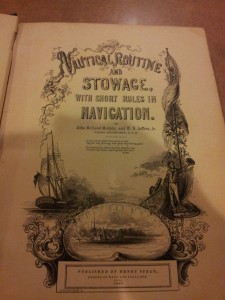 The first was being detailed enough about the nautical elements of the story for it to pass muster with people who love boats and can spot inaccuracies but not so obsessive about nautical stuff that it pulls readers out of the story. I like to use fun vocabulary generally, so using the same tricks that allow you to confidently toss around uncommon and lengthy words in books for kids helped here. It was also really helpful to have one protagonist who isn’t a sailor and hasn’t gotten confident with terminology or architecture or really any of the practicalities of sailing. Any time I figure Max would need something explained or spelled out, I figure a reader will, too (and vice versa).
The first was being detailed enough about the nautical elements of the story for it to pass muster with people who love boats and can spot inaccuracies but not so obsessive about nautical stuff that it pulls readers out of the story. I like to use fun vocabulary generally, so using the same tricks that allow you to confidently toss around uncommon and lengthy words in books for kids helped here. It was also really helpful to have one protagonist who isn’t a sailor and hasn’t gotten confident with terminology or architecture or really any of the practicalities of sailing. Any time I figure Max would need something explained or spelled out, I figure a reader will, too (and vice versa).
The second was making the War of 1812 accessible. I loved writing about this war because I think it’s relevant today for a lot of reasons, but if you’d asked me what it was really all about before I started researching I’d have had a hard time answering. It’s not one of the wars you learn much about in school, and it’s not easily reduced to a single memorable issue that sticks in the memory like the American Revolution, the Civil War, or World War 2. Plus, we didn’t win the War of 1812. We got trounced by Canada, fought to maybe a draw, and even the final treaty ignored one of the primary grievances we had with England. And while it was consequential for the United States, the War of 1812 was basically a spoiler conflict happening at the margins of the wars happening in Europe. It’s a fascinating moment, but it was hard to pin down without getting overly lecturey and expositional.
Biggest fear about the book:
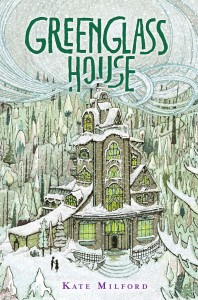 This one’s easy, and my friends and family already know the answer. I’m afraid people will be disappointed that The Left-Handed Fate isn’t like Greenglass House. Yes, it returns to Nagspeake, which was a total joy, but it isn’t cozy. It falls somewhere in the space between Greenglass House and The Boneshaker: a little more darkness than Milo’s story, a little more humor than Natalie’s. And there’s a hint of The Broken Lands in there, too, and not just because Liao is a character in both. Folks who’ve read all three of the earlier books (or five, if you count the Arcana companion books) know that Greenglass House is the outlier, but so many more people read Greenglass House than the others, it’s hard not to be worried.
This one’s easy, and my friends and family already know the answer. I’m afraid people will be disappointed that The Left-Handed Fate isn’t like Greenglass House. Yes, it returns to Nagspeake, which was a total joy, but it isn’t cozy. It falls somewhere in the space between Greenglass House and The Boneshaker: a little more darkness than Milo’s story, a little more humor than Natalie’s. And there’s a hint of The Broken Lands in there, too, and not just because Liao is a character in both. Folks who’ve read all three of the earlier books (or five, if you count the Arcana companion books) know that Greenglass House is the outlier, but so many more people read Greenglass House than the others, it’s hard not to be worried.
But in the end, if there’s one thing I have learned as a bookseller, it’s that not all books are for all readers. Still, it’s hard to apply that to my own books, when of course I want everyone in the world to love them all, especially the new one that I love to an unreasonable degree–but that’s plainly unrealistic. So this book won’t be for everyone, and that’s okay. And anyway, there’s Ghosts of Greenglass House coming out next year, so that’s comforting, too.
Biggest research problem:
Working out the architecture of the actual vessel called the Left-Handed Fate. But initially I wanted the Fate to be a really oddball vessel that looked nothing like anything else on the water–for those who’ve read Patrick O’Brian, I was thinking a bit about the “carpenter’s mistake,” the HMS Polychrest, if the “innovations” that made the Polychrest so dysfunctional had actually worked. But as I wrote I realized that constructing a ship like that was really outside my capability if I wanted to keep the nautical elements of the book realistic.
 Once I let go of that idea, I wanted the Fate to be a Baltimore-built clipper, which really became a thing just after the era of the book. So she became a topsail schooner that incorporated elements of some of the other types of vessels that influenced the builders of what would come to be called clippers. And really what kept messing with me was the lower deck layout. It took me so long to get around to nailing that down that Eliza Wheeler (whose patience is really one of the wonders of the world) had already begun drawing and both of us had to revise what we’d done to match the final layout.
Once I let go of that idea, I wanted the Fate to be a Baltimore-built clipper, which really became a thing just after the era of the book. So she became a topsail schooner that incorporated elements of some of the other types of vessels that influenced the builders of what would come to be called clippers. And really what kept messing with me was the lower deck layout. It took me so long to get around to nailing that down that Eliza Wheeler (whose patience is really one of the wonders of the world) had already begun drawing and both of us had to revise what we’d done to match the final layout.
Biggest hope for the book:
That it does well enough to justify returning to this era and these characters in another full-length novel. I think that’s always my biggest hope when a book comes out. I fall so deeply in love with the characters that I want to return to them again and again. Even though I’m supposed to be working on other things, ideas are already starting to swirl. I hope, I hope, I hope.
Partying, partying YEAH!*
August 19th, 2016COME TO MY PARTY! YOU ARE ALL INVITED.
Next week is the official launch of The Left-Handed Fate, and I couldn’t be more excited–unless, of course, you come out to celebrate with us!
There are two launch parties happening next week. If geographically convenient, please do come and hang out.
Tuesday, August 23 (LAUNCH DAY!!): McNally Jackson Books, 7pm
52 Prince Street (between Mulberry and Lafayette)

All ages are welcome; a story and some refreshments will be provided. Find additional details here.
Thursday, August 25: Barnes and Noble Annapolis, 6pm
Annapolis Harbour Center, 2516 Solomon’s Island Road
Again, all ages are welcome. At least one of my high school teachers has RSVP’d that she’ll be present, if you’ve been hunting for blackmail material. Find additional details here.
If you can’t make it but would like to join the festivities, there’s still time to order from one of the four special independent bookstores who have special gifts with preorders of The Left-Handed Fate. Find additional details here, but hurry, because quantities are limited.
*Nathan has played “Friday” several times at me in the past week in a not-very-covert attempt to game my Spotify Discover Weekly playlist to do ridiculous things and a probably not-unintended consequence of this is that I’ve had it stuck in my head since Sunday (which comes afterwaaaaarrrrrdd). I’ve also developed a terrible case of indecisiveness about whether I’d rather be kickin’ in the front seat or sittin’ in the back seat because STOP IT STOP IT STOP IT
Pre-Order THE LEFT-HANDED FATE, Get a Present from Me!
July 30th, 2016Well, we’re in the home stretch: just 24 days (as of July 30) until the launch of The Left-Handed Fate! And I hope like anything that you’re counting down the days, too.
 So, hey! Let’s talk about pre-orders. Some of you might know that I have strong feelings about the importance of independent bookstores. So for folks pre-ordering The Left-Handed Fate, if you pre-order from one of these bookmongers, I have a special gift for you. Actually, four special gifts, because each shop has something different. Order from any (or all!); they’re all happy to ship books anywhere in the country.
So, hey! Let’s talk about pre-orders. Some of you might know that I have strong feelings about the importance of independent bookstores. So for folks pre-ordering The Left-Handed Fate, if you pre-order from one of these bookmongers, I have a special gift for you. Actually, four special gifts, because each shop has something different. Order from any (or all!); they’re all happy to ship books anywhere in the country.
McNally Jackson Books, Soho, NYC
 The first 40 customers to pre-order from McNally Jackson will receive a numbered and signed paperback copy of Bluecrowne from the original 200-copy printing funded by Kickstarter and printed in the store on the Espresso Book Machine. Bluecrowne, for those who don’t know, is the first adventure of Lucy Bluecrowne, one of the main characters of The Left-Handed Fate, in the city of Nagspeake. It’s a standalone story, as is LHF–you don’t have to read Bluecrowne first–but you’ll definitely have special insights and information if you do. Order here.
The first 40 customers to pre-order from McNally Jackson will receive a numbered and signed paperback copy of Bluecrowne from the original 200-copy printing funded by Kickstarter and printed in the store on the Espresso Book Machine. Bluecrowne, for those who don’t know, is the first adventure of Lucy Bluecrowne, one of the main characters of The Left-Handed Fate, in the city of Nagspeake. It’s a standalone story, as is LHF–you don’t have to read Bluecrowne first–but you’ll definitely have special insights and information if you do. Order here. 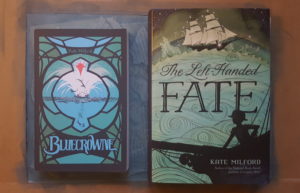
Little Shop of Stories, Decatur, GA
 The first fifty customers to pre-order The Left-Handed Fate from Little Shop of Stories will receive a letter-sized print of an architectural drawing of the topsail schooner letter-of-marque vessel, the Left-Handed Fate. This is a drawing I made for my own reference while writing and revising the book, only I fancied it up for you with some walnut ink and nice paper and some charmingly wobbly copperplate. (Note: by the time you receive your copy, the copperplate might be less wobbly and amusing, but I had to put something here to get this page up.) Order here.
The first fifty customers to pre-order The Left-Handed Fate from Little Shop of Stories will receive a letter-sized print of an architectural drawing of the topsail schooner letter-of-marque vessel, the Left-Handed Fate. This is a drawing I made for my own reference while writing and revising the book, only I fancied it up for you with some walnut ink and nice paper and some charmingly wobbly copperplate. (Note: by the time you receive your copy, the copperplate might be less wobbly and amusing, but I had to put something here to get this page up.) Order here.
Porter Square Books, Boston, MA
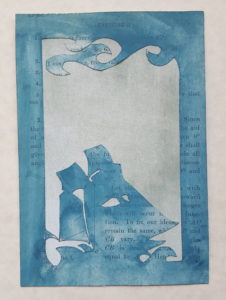 Customers who pre-order from Porter Square will receive a signed (and personalized, if you choose) handmade cut-paper bookplate. This is a thing I should probably not have done because I’m really not to be trusted with a knife this sharp. Also I cannibalized a vintage trigonometry book to do it. BUT THAT BOOK HAD IT COMING. (Note: Colors may vary, because I made this one before I knew what color the inside pages were.) Order here.
Customers who pre-order from Porter Square will receive a signed (and personalized, if you choose) handmade cut-paper bookplate. This is a thing I should probably not have done because I’m really not to be trusted with a knife this sharp. Also I cannibalized a vintage trigonometry book to do it. BUT THAT BOOK HAD IT COMING. (Note: Colors may vary, because I made this one before I knew what color the inside pages were.) Order here.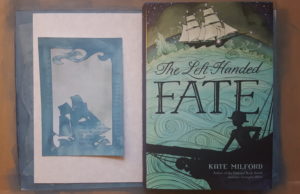
Oblong Books, Rhinebeck, NY
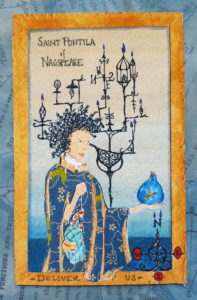 Customers who pre-order from Oblong Books will receive a bookmark in the form of a prayer card for Saint Pontila of Nagspeake, Patron Saint of Messages Sent in Bottles (to be clear, she looks out for the messages, not the senders or receivers, so invoke her at your peril). Those of you who’ve read The Broken Lands will already know a little about my fascination with prayer cards, although they have a different significance in The Left-Handed Fate. Order here.
Customers who pre-order from Oblong Books will receive a bookmark in the form of a prayer card for Saint Pontila of Nagspeake, Patron Saint of Messages Sent in Bottles (to be clear, she looks out for the messages, not the senders or receivers, so invoke her at your peril). Those of you who’ve read The Broken Lands will already know a little about my fascination with prayer cards, although they have a different significance in The Left-Handed Fate. Order here.
Coming soon: launch party information! But if you’re in the vicinity of NYC or Annapolis, MD, or plan to be at the end of August or need an excuse for a trip, mark your calendars!
NYC Launch: McNally Jackson Books, Tuesday, August 23 7pm. All ages welcome.
Annapolis Launch: Barnes and Noble Annapolis, Thursday, August 25, 6pm. All ages welcome.
